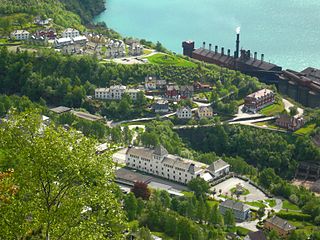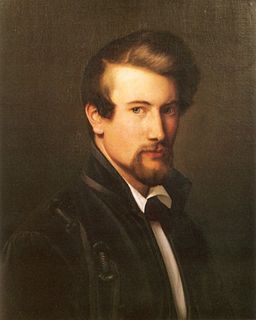Halldor Olson Opedal (May 26, 1895 – January 17, 1986) was a Norwegian teacher and folklorist from Lofthus in the Hardanger district. [1] [2]

Norwegians are a North Germanic ethnic group native to Norway. They share a common culture and speak the Norwegian language. Norwegian people and their descendants are found in migrant communities worldwide, notably in the United States, Canada, Australia, Argentina, Chile, Uruguay, Brazil, Mexico, New Zealand, the United Kingdom, and South Africa.

Lofthus is a village in the municipality of Ullensvang, which is located in the Hardanger region of Hordaland county, Norway. The village lies along the eastern shore of the Sørfjorden, along Norwegian National Road 13. Lofthus is located about 10 kilometres (6.2 mi) south of the village of Kinsarvik and about 30 kilometres (19 mi) north of the town of Odda. The 0.67-square-kilometre (170-acre) village of Lofthus has a population (2013) of 556, giving the village a population density of 830 inhabitants per square kilometre (2,100/sq mi).

Hardanger is a traditional district in the western part of Norway, dominated by the Hardangerfjord and its inner branches of the Sørfjorden and the Eid Fjord. It consists of the municipalities of Odda, Ullensvang, Eidfjord, Ulvik, Granvin, Kvam, and Jondal, and is located inside the county of Hordaland.
Opedal was trained as a teacher and worked in Tyssedal for 37 years. [2] He traveled extensively in the area and collected folk tradition and dialect material from the Hardanger countryside by listening to old people who were skilled at telling stories. His two largest series of books were titled Makter og menneske: folkeminne ifrå Hardanger (Power and People: Folk Tradition from Hardanger, 22 volumes) [1] and Folk or gamal tid: folkeminne ifrå Hardanger (Folk from Old Times: Folk Tradition from Hardanger, eight volumes). [2] Opedal also wrote a description of the people at the Kjeåsen mountain farm in the Simadal Fjord titled Kjeåsfolket i Hardanger. Soga om eit utkantfolk (The People of Kjeåsen in Hardanger. The Story of an Unknown People, 1980), [3] which was also translated into Swedish. [4] Opedal's total book production runs to 7,500 pages. [2]

Tyssedal is a village in Odda municipality in Hordaland county, Norway. The village is located on the shore of the Sørfjorden about 6 kilometres (3.7 mi) north of the town of Odda. Tyssedal is located in an environment in a valley between the fjord to the west and the mountains leading up to the Hardangervidda mountain plateau to the east.

Kjeåsen is a mountain farm in the municipality of Eidfjord in Norway's Hardanger district, in Hordaland county. The farm lies at an elevation of 513 meters (1,683 ft) at the innermost point of the Simadal Fjord. The farm is no longer being worked, and one person lives there during the summer. The site is popular with tourists, especially Swedes. The farm has been referred to as "the world's most inaccessible farm."

The Simadal Fjord is a branch of the Eid Fjord in the municipality of Eidfjord in Hordaland, Norway. The Simadal Fjord is the innermost branch of the Hardanger Fjord. It is 5 kilometers (3.1 mi) long and extends east from its mouth between Blurnes and Eikenes to the head of the fjord at the Sima Valley.
Opedal received the King's Medal of Merit in gold in 1961. In 1975, he was awarded the Arts Council Norway Honorary Award for local history in recognition of his work with folk culture in Hardanger. [1] [2] In 1975, Opedal created the Halldor O. Opedal Fund for Norwegian Language Development with a capital of NOK 600,000, and he established the Halldor O. Opedal Fund for Charitable Purposes, with a capital of NOK 2.8 million to benefit cultural aims in Hardanger. [2]

The King's Medal of Merit is a Norwegian award. It was instituted in 1908 to reward meritorious achievements in the fields of art, science, business, and public service. It is divided in two classes: gold and silver. The medal in gold is rewarded for extraordinary achievements of importance to the nation and society. The medal in silver may be awarded for lesser achievements. The medal is suspended from a ribbon in the colours of the Royal Standard of Norway.

The Arts Council Norway Honorary Award is awarded annually by the Arts Council Norway. The prize is awarded annually to a person who has made a significant contribution to Norwegian art and culture. The prize committee does not solicit nominations and the decision on award is made in closed meeting. Traditionally, no decision basis for the award is announced.

The krone[ˈkruːnə], plural kroner, is the currency of Norway and its dependent territories. It is subdivided into 100 øre, which have existed only electronically since 2012. The name translates into English as crown.
Opedal died in Ullensvang in 1986. A bronze bust of Opedal, created in 1995 by Oddmund Raudberget, is displayed in the center of Lofthus today.

Ullensvang is a municipality in Hordaland county, Norway. It is located in the traditional district of Hardanger. The administrative centre is the village of Kinsarvik. Other villages in the municipality include Lofthus, Utne, Vikebygd, and Alsåker.
Oddmund Raudberget is a Norwegian artist, painter, and sculptor.








